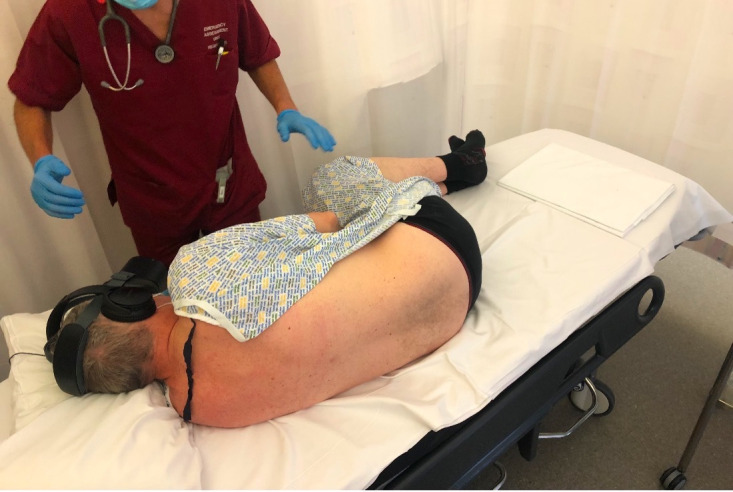Abstract
Background
Virtual reality is increasingly being used as an adjunct or replacement to pharmacological analgesia and sedation during medical procedures.
Methods and results
We report the successful use of a virtual reality device in a highly anxious patient undergoing lumbar puncture.
Conclusion
The case demonstrates how virtual reality technology may benefit patients undergoing invasive procedures such as lumbar puncture. Virtual reality may, therefore, offer an alternative or adjunct to sedation and analgesia and may reduce the amount of pharmacological therapy required.
Keywords: HEALTH POLICY & PRACTICE, INTERVENTIONAL, PAIN
Report
A 63-year-old man was referred for assessment of recurrent episodes of collapse. MRI suggested raised intracranial pressure and the patient was admitted for an elective lumbar puncture to assess cerebrospinal fluid and measure opening pressures. The patient was also under the care of the adult mental health team and was being treated for somatoform disorder with severe anxiety and depression. On admission, the patient was highly anxious about his current symptoms as well as the lumbar puncture procedure. He was identified as a potential candidate that may benefit from a virtual reality (VR) device to improve tolerability and the hospital’s clinical VR team were contacted for assistance.
The VR system that was chosen was a Healthy Mind (Paris, France) Pico device with headphones. The immersive scene within the software includes a three-dimensional natural location, environment-based hypnotherapy scripts, accompanying music, relaxation features to encourage deep breathing, and distraction techniques to focus attention away from the clinical procedure. The patient was given verbal and written information about the VR device and the potential benefits it may have to him during the procedure. He was also given the opportunity to try on the VR headset and headphones before the procedure commenced and make a choice as to which immersive scene he might find the most relaxing during the procedure. The patient opted for an underwater scene (figure 1). He was informed that the clinical team would be able to communicate with him during the procedure using the text feature of the device, whereby he would receive written notifications within the immersive scene (eg, before local anaesthetic was administered). The patient was also informed that he could gain the clinical team’s attention during the procedure by raising his hand.
Figure 1.
Underwater immersive environment as seen by the patient
The lumbar puncture lasted 20 min and proceeded without complication (figure 2). The patient’s well-being was checked regularly throughout the procedure, and he remained calm throughout. Approximately 10 min into the procedure, the patient fell asleep and remained so for the duration of the procedure. Verbal feedback was obtained about the patient’s experience of the procedure using the VR device and he reported that the VR system helped him to forget what was happening and relax more.
Figure 2.

Patient in left lateral position using the virtual reality headset and headphones.
Clinical VR is a rapidly evolving sector with benefits being applied to a wide range of settings within healthcare. It is hypothesised that VR reduces pain by providing an effective distraction away from the painful stimuli that the patient would otherwise be focused on.1–5 This results in less attentional resources available to process nociceptive signals.6 In addition to a reduction of subjective pain perception, VR has also been shown to reduce pain-related brain activity on functional MRI.7 8
The case presented here demonstrates how VR technology may benefit patients undergoing invasive procedures such as lumbar puncture. VR may, therefore, offer an alternative or adjunct to sedation and analgesia and may reduce the amount of pharmacological therapy required.
Footnotes
Twitter: @mitcharj
Contributors: KH and CB wrote the first draft which was then edited and revised by AG and AM. AM is guarantor.
Funding: The authors have not declared a specific grant for this research from any funding agency in the public, commercial or not-for-profit sectors.
Competing interests: None declared.
Provenance and peer review: Not commissioned; internally peer reviewed.
Data availability statement
Data sharing not applicable as no datasets generated and/or analysed for this study. Not applicable.
Ethics statements
Patient consent for publication
Consent obtained directly from patient(s)
Ethics approval
Not applicable.
References
- 1.Hoffman HG, Doctor JN, Patterson DR, et al. Virtual reality as an adjunctive pain control during burn wound care in adolescent patients. Pain 2000;85:305–9. 10.1016/S0304-3959(99)00275-4 [DOI] [PubMed] [Google Scholar]
- 2.Birnie KA, Chambers CT, Spellman CM. Mechanisms of distraction in acute pain perception and modulation. Pain 2017;158:1012–3. 10.1097/j.pain.0000000000000913 [DOI] [PubMed] [Google Scholar]
- 3.Dahlquist LM, McKenna KD, Jones KK, et al. Active and passive distraction using a head-mounted display helmet: effects on cold pressor pain in children. Health Psychol 2007;26:794–801. 10.1037/0278-6133.26.6.794 [DOI] [PubMed] [Google Scholar]
- 4.Gold JI, Belmont KA, Thomas DA. The neurobiology of virtual reality pain attenuation. Cyberpsychol Behav 2007;10:536–44. 10.1089/cpb.2007.9993 [DOI] [PubMed] [Google Scholar]
- 5.Zeroth JA, Dahlquist LM, Foxen-Craft EC. The effects of auditory background noise and virtual reality technology on video game distraction analgesia. Scand J Pain 2019;19:207–17. 10.1515/sjpain-2018-0123 [DOI] [PubMed] [Google Scholar]
- 6.Pourmand A, Davis S, Marchak A, et al. Virtual reality as a clinical tool for pain management. Curr Pain Headache Rep 2018;22:53. 10.1007/s11916-018-0708-2 [DOI] [PubMed] [Google Scholar]
- 7.Hoffman HG, Richards TL, Van Oostrom T, et al. The analgesic effects of opioids and immersive virtual reality distraction: evidence from subjective and functional brain imaging assessments. Anesth Analg 2007;105:1776–83. 10.1213/01.ane.0000270205.45146.db [DOI] [PubMed] [Google Scholar]
- 8.Hoffman HG, Richards TL, Coda B, et al. Modulation of thermal pain-related brain activity with virtual reality: evidence from fMRI. Neuroreport 2004;15:1245–8. 10.1097/01.wnr.0000127826.73576.91 [DOI] [PubMed] [Google Scholar]
Associated Data
This section collects any data citations, data availability statements, or supplementary materials included in this article.
Data Availability Statement
Data sharing not applicable as no datasets generated and/or analysed for this study. Not applicable.



